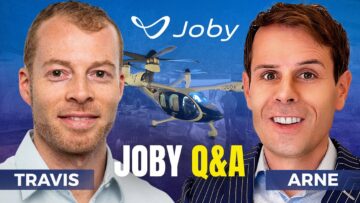Toyota tops up investment to $US894 m
Joby Aviation (NYSE: JOBY, WKN: A3CWWU) wants to redefine the concept of the air cab and use its solutions to help us spend significantly less of our lives getting from A to B. Especially if the route does not lead from London to Shanghai, but “only” replaces the trip to the airport or enables a visit to a very remote region without a well-developed road network.
Mobility is one of the hallmarks of our modern world. Cars, trains and airplanes represent it figuratively. Many people use their cars, usually for short to medium distances. Fewer people fly, but usually to more distant destinations. Most of us do not associate individual mobility with the idea of using an airplane like a cab and landing not far outside a metropolis, but virtually directly at our destination. Not yet, because Joby Aviation has set out to make precisely this vision a reality.
Joby Aviation uses the example of New York City to show how today might differ from tomorrow. Imagine you are visiting the city and standing on the southern tip of Manhattan, very close to the new World Trade Center. But your time in New York is coming to an end. Your departure is approaching and you need to get to JFK Airport. Like most airports, it is located far outside the city.
The choice is yours: you can take a cab or travel by subway. By car you need 49 minutes if everything goes smoothly and no traffic jams extend your travel time. Joby Aviation wants and is working hard to provide you with another alternative in the future, an electric air cab. It would take off from the Downtown Heliport in the very south of Manhattan. On departure, you take one last look at the Statue of Liberty and just seven minutes later you are at the airport.
A vision becomes reality
A beautiful dream? No, rather a vision that is about to become reality, because Joby’s air ride-sharing service will combine the ease of conventional carpooling with the power of flight. The aim is to create a green alternative to traveling by car that can be conveniently booked via an app. For this to succeed, the airplane must be able to blend into the background of our normal lives.
This is technically possible with a battery-powered aircraft. It has adjustable propellers and can therefore take on the characteristics of both an airplane and a helicopter. The US Navy already uses this concept on its aircraft carriers. The difficulty here is that there is very little space available for landing and taking off. Vertical take-off jet fighters have been known and used for a long time. However, they make a lot of noise and are correspondingly expensive.
For smaller reconnaissance aircraft that do not need to fly at supersonic speeds, the aviation industry has therefore developed smaller aircraft for the US Navy that take off and land like helicopters but fly like a normal aircraft during flight. The solution to this problem was propellers that can be adjusted. During take-off and landing, the propeller is positioned so that it is horizontal to the ground. During flight, the angle of the propeller is rotated by 90 degrees so that the propeller is perpendicular to the ground, just like a normal airplane.
Environmentally friendly electric flying
However, unlike the models operated by the US Navy on its aircraft carriers, Joby Aviation has opted for electric propulsion for its aircraft. At six, the number of rotors is also significantly higher than in classic propeller aircraft. Long runways are no longer necessary because, like a helicopter, the aircraft can land basically anywhere where there is space, even in the canyons of New York.
Joby Aviation has now flown more than 30,000 miles with its full-size prototypes and the aircraft are designed to meet the uncompromising safety standards of the FAA and other global aviation authorities. Joby is currently in a multi-year testing program with the FAA to certify the vehicle for commercial operations. In this five-stage program, the first three stages have already been completed in full and a third of the fourth stage has also been successfully completed.
The United Arab Emirates and Toyota show great interest
While the process of testing and approving the aircraft is underway, Joby is already focusing on marketing its product. The idea of a battery-powered air cab has been very well received in the United Arab Emirates and by Toyota. In Dubai, Joby’s founder and CEO, JoeBen Bevirt, signed a letter of intent with the UAE General Civil Aviation Authority in February of this year, which will pave the way for Joby’s air cabs in the Emirates. In September, Joby Aviation was then certified as the first provider of electric air cabs in Dubai.
Even more significant was the expansion of Toyota Motor’s involvement announced on October 2. The Japanese company plans to invest a further 500 million US dollars in Joby Aviation in two equal tranches. This brings their total investment to 894 million US dollars. The first half of the additional investment is to be made this year, the second in 2025.
On the one hand, Toyota wants to support the ongoing certification process and preparations for commercial production. The Japanese company is willing to enter into a long-term alliance with Joby Aviation for the production of air cabs. Within this cooperation, Toyota intends to supply Joby with important control and drive components for the production of the new aircraft.
On Wall Street, the signs are pointing to a rally again
On the New York Stock Exchange, investors reacted to this news with a strong rally, temporarily pushing the Joby share price back above the USD 6.00 threshold. This must now be overcome in the long term so that the July high of USD 7.46 can be reached again as the next interim target. If this hurdle can also be overcome permanently, the resistance band between USD 10.00 and USD 10.20 is the next target.
So things remain exciting at Joby Aviation. It is not just the share price that looks very promising at the moment. The underlying business model is also very attractive. Goldinvest will therefore stay on the ball and continue to monitor this exciting and interesting investment opportunity closely for you.
Disclaimer: GOLDINVEST Consulting GmbH publishes comments, analyses and news on https://goldinvest.de. These contents are exclusively for the information of the readers and do not represent a call to action, neither explicitly nor implicitly they are to be understood as an assurance of possible price developments. Furthermore, they are in no way a substitute for individual expert investment advice and do not constitute an offer to sell the discussed stock(s) or a solicitation to buy or sell securities. It is expressly not a financial analysis, but a promotional/journalistic text. Readers who make investment decisions or execute transactions on the basis of the information provided here do so exclusively at their own risk. There is no contractual relationship between GOLDINVEST Consulting GmbH and its readers or the users of its offers, because our information refers only to the company, but not to the investment decision of the reader.
The acquisition of securities is associated with high risks, which can lead to a total loss of the invested capital. The information published by GOLDINVEST Consulting GmbH and its authors is based on careful research. Nevertheless, any liability for financial losses or the content guarantee for topicality, correctness, adequacy and completeness of the articles offered here is expressly excluded. Please also note our terms of use.
Pursuant to §34b WpHG and §48f Abs. 5 BörseG (Austria) we point out that GOLDINVEST Consulting GmbH and/or partners, principals or employees of GOLDINVEST Consulting GmbH hold shares in Ucore Rare Metals and therefore a conflict of interest exists. GOLDINVEST Consulting GmbH also reserves the right to buy or sell shares of the company at any time. In addition, GOLDINVEST Consulting GmbH is remunerated by Ucore Rare Metals for reporting on the company. This is another clear conflict of interest.



















